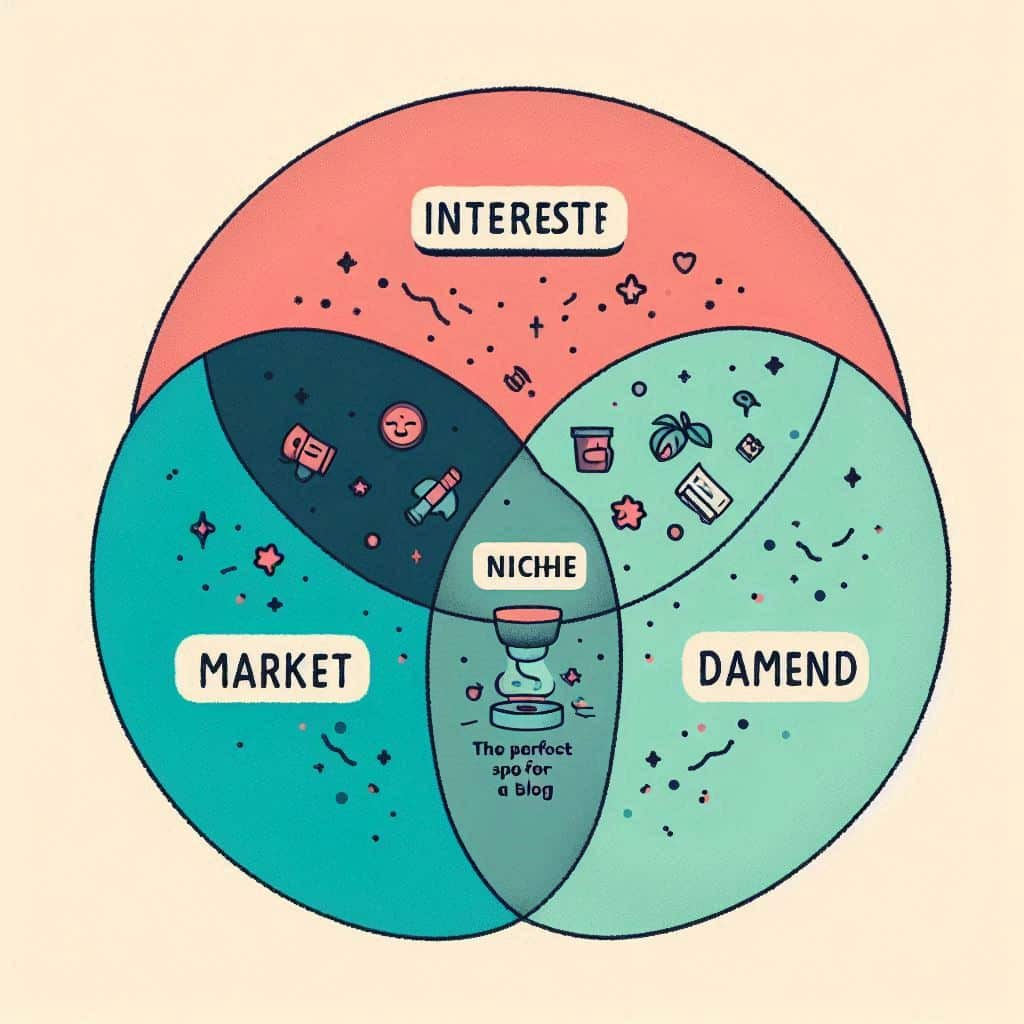Have you ever felt lost in the blogging world, wondering where to plant your flag? You are not alone. Choosing a blog niche is about picking the perfect spot for a picnic: Get it right, and you’re in for a treat. Get it wrong? You might end up with ants in your sandwiches.
I’ve done this too—staring at my screen, cursor blinking. What in tarnation am I to blog about? However, the absolute truth is that finding your perfect blog niche really doesn’t need to be some headache-inducing puzzle.
Take a deep breath and follow me through these 10 steps to find the ultimate blog niche that will make your best content content strategy in 2024 and bring it back for more:
By the end of this, at a minimum, students will learn how to find their passion-driven niche, tap into a hungry market, and create a blog that stands apart from the crowd. Do you know you’re ready to get into your blogging sweet spot? Let’s dive in and make some magic happen!
Table of Contents
What is a Niche, and how do you choose a blog niche
A blog niche is the subject matter or specific focus point of your blog. It is the subject that you will consistently cover on your blog.
It’s your blog’s specialty. Just like a pizza shop is known for great pizza, your blog will be known for serving compelling information about a particular topic.
A niche could be something like “health and wellness.” There’s a balance between being too broad and too specific.
Your topic of choice is usually the most critical decision you make in the blogging world. This is how you get it right:
- Start with your passion: What are you interested in learning more about or discussing at length?
- Assess what you are experienced in: Think about your skills and knowledge. What is your expertise?
- Probe market requirement: Check, using keyword research tools, whether people are searching for your chosen topic on the market.
- Investigate your competition in the field: Check the blogs on your potential niche. Will your voice be heard?
- Consider profitability: Some niches pay more on the market than others. Consider researching potential income streams.
- Think long-term: Select a niche that you will enjoy writing about for years to come.
- Find your unique angle: What fresh angle can you give to the topic?
Remember, choosing a niche depends on the intersection of your interests, skills, and market demand. It is where passion meets profitability.

When you take the time to select the right niche, you lay the foundation for a successful blog. This is an investment in your future blog, and it will bring you really interested readers and some additional income.
Step -1: Identify Your Passions and Expertise
The first step in choosing a blog niche is an introspective process. It would help if you
decided what interests you genuinely and also know your strengths.
Brainstorming interests
Make a list of all your interests. Think about your hobbies, favorite subjects, and what you usually do when you have free time.
Don’t be a snitch – pick on even the most minor interests. Sometimes, a very narrow interest will blow your mind into something that could be a potential blog niche.
Checking your knowledge and skills
Now, refer to this list, and beside each item, consider what you know about it. Where have you developed expertise?
Think about your work experience, education, and life experiences. All of these contribute to your knowledge base.
Think about the topics you feel comfortable teaching others about. In many cases, these are the topics where your passion and knowledge intersect and often the perfect blog niche.
Remember, you don’t need to be a world-class expert. You need only to know more than your target audience.
If your blog is centered on topics that interest you and that you are highly knowledgeable about, you will find it much easier to develop consistent content and keep it engaging.
How I Found My Blogging Niche
When I started my blogging journey, I was all over the place. I thought I needed to write about everything under the sun.
One day, I sat down and really thought about what I loved. I realized I spent hours reading about personal finance and budgeting. I was always the friend giving money advice.
But I wondered, “Is this too boring? Will anyone care?”
So, I did some digging. I looked at search trends and found tons of people asking about budgeting and saving money. There was a real need for simple, down-to-earth financial advice.
That’s when it clicked. I could combine my passion for finance with my knack for explaining complex things simply. My niche would be “Personal Finance for Beginners.”
It wasn’t an overnight success. I had to refine my content strategy and really understand my target audience. But focusing on this niche helped me:
- Create more focused, helpful content
- Build a loyal readership
- Eventually, monetize through affiliate marketing and a budget planner
The lesson? Sometimes your perfect niche is hiding in plain sight. It’s about connecting the dots between what you love, what you’re good at, and what people need.
This self-reflection was key to finding a niche that felt authentic to me and valuable to others. It turned my blog from a scattered hobby into a thriving platform.
Step -2 : Research Market Demand
Once you have found your interests, it is time to determine whether audiences are interested in them. This step is crucial in selecting a viable blog niche.
Keyword research tools
Keyword research tools will also tell you what people are searching for online. They are required to judge market demand.
Start with the free ones: Google Keyword Planner and Ubersuggest. Input some of the topics on your list of interests and see what search volumes they return.
Look for keywords that return decent search volumes, meaning people are interested in the subject.
Look at related keywords, too. They will give you ideas relating to specific angles within your niche.
Searching trends
Search trends indicate whether the interest in a topic is on the rise, flat, or falling.
- Go to Google Trends and try out how popular your possible niches are by typing your keywords and drawing the trend lines.
- Look for topics with stable or increasing interest. These are more likely to be sustainable blog niches.
- Avoid topics with firmly falling trends. They may need opportunities for long-term blogging.
- Also, consider seasonal trends: some niches will spike in interest periodically.

By researching market demand, you will ensure that there are people who will be interested in reading your content. This will give you an edge in building a successful blog.
Step -3 :Define Your Target Audience
Understanding who you are writing for will play a significant role in the success of your blog. Knowing your audience shapes your content strategy and increases the level of audience engagement.
Creating audience personas
Who do you want to be reading your blog? What are the characteristics
Think about their age, occupation, areas of interest, their goals. That really creates a fleshed-out target audience profile.
Consider the aspects related to their internet behavior: Which websites do they visit? Which social media platforms are they on?
Formulate 2-3 personas that encapsulate your key audience. This will make it very clear who you are writing for.
Pain Points
Knowing your audience’s problems is the key to developing content that will resonate with them.
What are the main challenges that your target audience faces in relation to your specific industry or area of expertise? How can your blog help solve those problems?
Research forums, social media discussions, and comments on similar blogs. These will often identify ordinary pain points among readers.
Use surveys or social media polls to ask potential members of your audience about their pain directly.
By knowing what these are, you can generate content that truly resonates with your readers.
Keep in mind that you want to be the first resource they turn to for information within your niche. Creating personas and addressing specific needs can help you achieve this goal.
Extensive personas and an understanding of pain points give your content a clear direction. A more targeted approach could then really drive up engagement and loyalty among your readership.

It will help you ensure that your blog’s niche is relevant to the needs of actual readers. This is a crucial step in creating a successful outcome. Blog—one that serves its audience well.
Case Study: How Sarah’s Fitness Revolution Got Its Target Audience Right
Personal trainer Sarah was getting more headway with her fitness blog when she resized her target audience. Here’s how she turned around:
Initial Approach:
- Extensive focus: “fitness for everyone”
- Generic diet and exercise content
- Low engagement and growth
- Audience Reset:
- Niche: busy working moms, 30-45
- Persona: “Michelle, 37, marketing manager, two kids.”
- Critical pain points identified: No time, energy, or motivation.
- Shift in Content Strategy:
- 15-minute workouts for the busy schedule
- Fast, healthy meal prep
- Fit tips to fit into family life
Results:
- 3x growth in blog traffic in 6 months
- 5x growth in email subscribers
- Successful launch of a “Fit Mom” coaching program
Key Takeaway: This understanding of the target audience and the need to narrow down her focus enabled her to turn her blog into a platform that was quite successful and had strong resonance with the readers.
This case study explains just how crucial it can be to define your target audience. This makes all the difference between having a struggling blog and a highly effective one within a chosen niche.
Step -4 : Assess Monetization Potential
When choosing a blog niche, it pays to consider how you’ll make money. Let’s examine the different options for profitable blogging.
Income Streams
Various niches really lend themselves to different monetization streams. Here are some of the popular options:
- Affiliate marketing: Help sell products in your niche and receive commissions.
- Digital products: Create and sell ebooks, courses, or templates.
- Sponsored content: Partner with brands for paid posts or reviews.
- Advertising: plunk display ads on your blog through networks like Google AdSense.
- Coaching or consulting: Sell access to your knowledge directly to clients.
Some Niches, then, will lend themselves more to one revenue stream than another. For example, affiliate marketing works very well for tech blogs, while digital courses are more in demand on personal development blogs.
How to know if a niche is profitable
Not all niches are equal in terms of their profit potential. Here’s how to estimate their potential:
Research niche competitor blogs and look for telltale signs, such as signs of monetization, product promotions, or sponsored posts within the blog itself. Look for affiliate programs related to your specific niche.
High commissions correspond to good profit potential. Look through job boards or freelance sites; if there is a massive demand for writers in your niche, this can often be indicative. Consider purchasing power in your target audience—specific niches really do tend to attract spending readerships.
Yes, profitability does not depend on the choice of a lucrative niche but also on how you serve your audience and execute this content strategy.
Statistics
According to one survey, lifestyle blogs average approximately $5,000 per month, while a finance blog can go as high as $9,000 per month. However, results are very personified and depend on audience size and monetization strategies applied.
By considering monetization options early enough, you set yourself up to be viable for the long term within the niche that interests you. It’s finding that sweet spot between what drives your passion and profit potential.

Step -5 : Analyze Competition
Competitive analysis is another factor in choosing a blog niche. I learned that knowing your rivals will also help you discover opportunities and challenges.

Identify top players in your niche.
Research top blogs, influencers, and websites in your target niche. Analyze their content, see how audiences engage with them, and learn how they make money. This will help you get a feel for what’s trending, what topics are hot, and what formats perform well.
Content Gaps
Take note of what your competitors need to cover. Find underserved topics, emerging trends, or even different perspectives on a given subject. This is where you can create quality, unique content that will help you differentiate in your niche.
Step -6 : Run Your Niche Idea by Them
However, it would help if you did not commit to a niche before properly validating it. In the long term, this could save you loads of time and resources.

Sample Content Creation
Develop a few blog posts or articles about your niche. Ensure that these are good, unique, and well-aimed to your targeted audience. Target the following keywords: “niche validation,” “content creation,” and “audience targeting.”
Gather Feedback
Share your sample content with potential readers, peers, or mentors. Get honest opinions on relevance, value, and appeal. Share on social media, forums, or niche communities to see if people are interested. Keywords: “audience feedback,” “content evaluation,” and “niche validation.”
Step -7 : Consider Long-Term Viability
When choosing a blog niche, I always tell students to consider more than ‘now.’ Finding sustainable success requires foresight and adaptability.

Gaining an idea of niche growth potential
Research the prospects for your chosen niche. Is this a passing trend or a growing field? Read market and industry reports, checking for upcoming new technologies. Look for ones that show steady or rising demand. Keywords: “market analysis,” “niche sustainability,” “growth forecasting.”
Be able to forecast trends in the industry.
Be sure to know what is happening next in your niche. Join a few significant influencers, attend conferences, and read publications about your industry. This will put you in a position to identify emerging sub-niches or complementary topics that can help broaden the scope of your content. Such foresight can cement your authority status.
Step -8 : Niche Down
I learned that a well-defined niche is usually better than broad topics. Specificity could bring about high engagement and more precise content direction, as one will know where they are headed.

Pick a Niche Angle.
Refine the niche by selecting a specific perspective or subtopic; often, this would be an individual demographic, problem, or approach for your broad niche. For instance, “home workouts for busy professionals” instead of “fitness.” Keywords: “niche specialization,” “target audience refinement.”
Define the unique selling proposition.
Identify what differentiates your blog from the competition. What value are you bringing to your readers? It may be your experience, expertise, or a new way of doing things. Generate an exact statement of what sets your blog apart and what your audience will benefit from it.
Step -9 : Validate Your Niche
I always recommend checking if your niche is viable. It will save you hours of headaches later on.

Surveys
Design questionnaires to learn from your potential audience. Leverage online survey tools to reach more demographics: survey pain points, content preferences, and information gaps. Based on the responses, refine a niche focus. Keywords: “audience research,” “market validation,” “niche survey.”
Talking to potential readers
Engage with them directly. Create or join an online community, forum, or social media group relevant to your niche. Watch the conversations unfold and participate in discussions. Ask questions. Firsthand contact with your audience is likely to disclose the most valuable information concerning their needs and interests.
Step -10 : Commit and Start Creating
Commit to your niche once it is validated. A well-defined plan helps you easily create and maintain momentum and consistency.

Develop a Content Strategy
Plan the creation and distribution of your content, including topic clusters, content types, and posting frequency. Seasonality and evergreen topics must be accounted for. An editorial calendar keeps everything in line. Keywords: “content planning,” “editorial strategy,” “blog organization.”
Building the base of your blog
technically set up a blog with a domain, hosting, and content management system; design the layout for your blog and create basic pages such as About and Contact; set up analytics tools—this will be the bedrock for your growing library of content.
FAQ’S
How Do I Choose the Right Niche for My Blog?
Pick a topic you like and for which there is market demand. You will want to research potential niches by evaluating the competition and areas of your expertise. Keywords: niche selection, market research, passion project
What is the ideal length of blog posts?
Aim for 1,500-2,500 words for highly comprehensive posts. It’s not the length that counts but rather the quality and relevance of the content to the targeted reader. Mix long and short-form articles. Keywords: content length, SEO optimization, reader engagement
How often should I post new content to my blog?
Be consistent. You want to shoot for 1-3 high-quality posts per week, but adjust that based on your specific niche and resources. After all, quality trumps quantity. Keywords: posting frequency, content calendar, blogging consistency
How can I monetize my blog?
The most common methods include affiliate marketing, sponsored content, digital products, and advertising. Choose the monetization paths that your niche and audience recommend.
How would I best promote my blog?
Describe social media, email marketing, guest posting, and search engine optimization. Remember to include an approach to caring for your audience or other bloggers in the niche. Keywords: blogging, promoting a blog, social media, email marketing, guest posting, search engine optimization
How important is SEO when blogging?
SEO is crucial for organic traffic growth. Focus on keyword research, on-page optimization, and creating valuable content. But always prioritize user experience. Keywords: search engine optimization, organic traffic, keyword strategy.
Why is SEO necessary for increasing organic traffic?
Focus on keyword research, on-page optimization, and quality content. However, work backward to consider the user experience first. Keywords: search engine optimization, organic traffic, keyword strategy
Should I target a wide or narrow niche?
A narrow focus typically equates to an involved audience with much less competition. But don’t let it be so narrow that it hurts your potential for long-term growth.
How do I improve my writing skills in order to blog?
Write consistently, read widely in your niche, and learn to take feedback. Take writing classes or workshops. Experiment with different styles and formats. Keywords: writing improvement, blogging skills, content creation
What tools are essential in blogging?
Essential tools include:
- A sound content management system.
- SEO plugins.
- Analytics software.
- Scheduling tools for social media.
Choose as per your requirements and budget. Keywords: tools for blogging, productivity software, content management
How Much Time Is Involved In Really Building A Successful Blog?
Building a successful blog usually requires 12-24 months of continuous diligent work. Be patient, keep working at producing quality content, and keep your head on creating an audience while refining your approach. Keywords: blog growth, long-term strategy, content consistency
Conclusion:
You don’t need to gamble when choosing a niche for your blog. Following these steps—from your passion to competition analysis—you are really setting yourself up for blogging success.
The perfect niche is just out there, waiting for you. You know that sweet spot when all your interests and expertise come into play with market demand, and everything clicks into beautiful harmony? Well, what are you standing there for? Crack open that notepad and fire up those research tools; let the journey begin. Your perfect blog niche is just around the corner, and man is it ever going to be a wild ride.
Here are 120 blog niche ideas that you can see if any of its fit to your interest.
Happy niche hunting, future blogging superstar!

